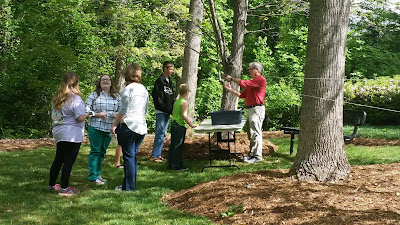Our final library class for the school year with Mr. Jack, focused on calculating speed. Now, the kiddos aren't particularly morning people or math people. They can cipher, but that isn't their favorite activity. Luckily, they were going to use rockets in this procedure. Oh, and a calculator!
Mr. Jack introduced the subject by having them perform a task in the classroom. J-man volunteered to walk the line while Egee and B-man ran stop watches. Next, Mr. Jack showed them an equation to use to calculate speed. They compared their calculations and a discussion ensued over why longer distances are better to use than shorter distances for an average speed calculation.
Mr. Jack then instructed the crew to build 'rockets' with only a cone and no fins. They weren't sure of what to think about that. Once they got outside they understood why.
Instead of a vertical lift-off or launch, the rockets were attached to a horizontal, string guide. Mr. Jack 'launched' the rocket and the children recorded the amount of time it took the rocket to travel forty feet. They then did the calculation to figure out speed.
Although, all the rockets were essentially the same, some traveled faster than others. They discussed what may be causing the difference. Amount of water in the rocket? Amount of paper used for the cone? Size of the cone? Pressure inside the rocket?
They learned that many variables can impact the speed of an object. They also came to understand why using a longer distance to calculate average speed was easier than using a shorter distance.









